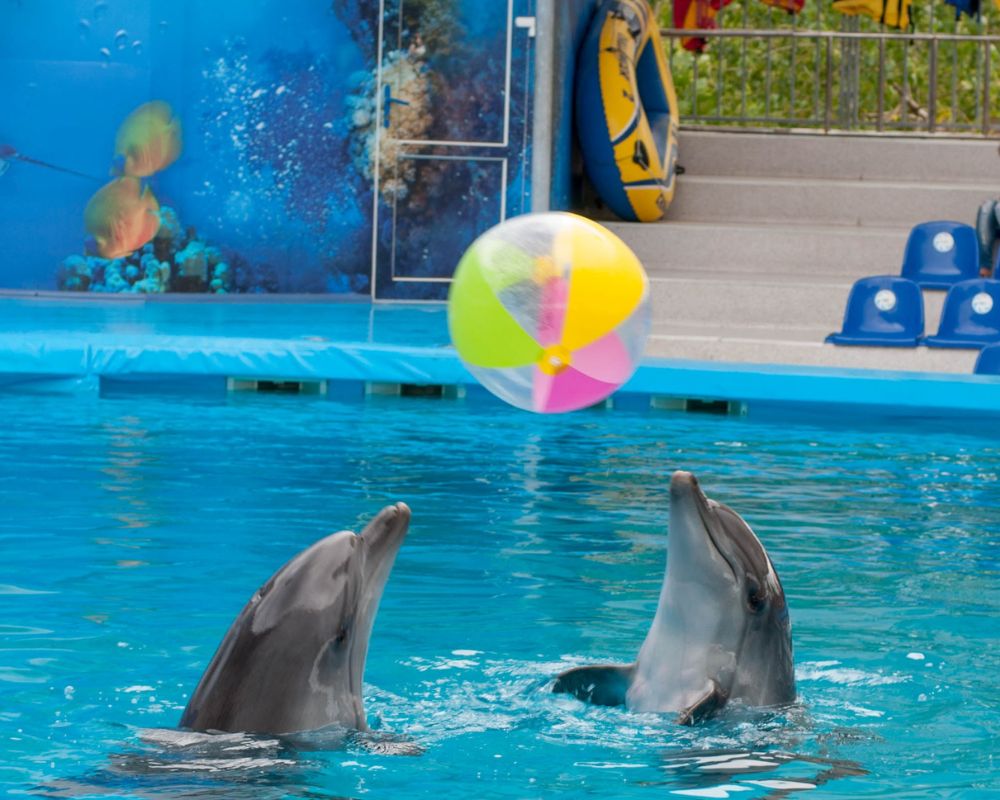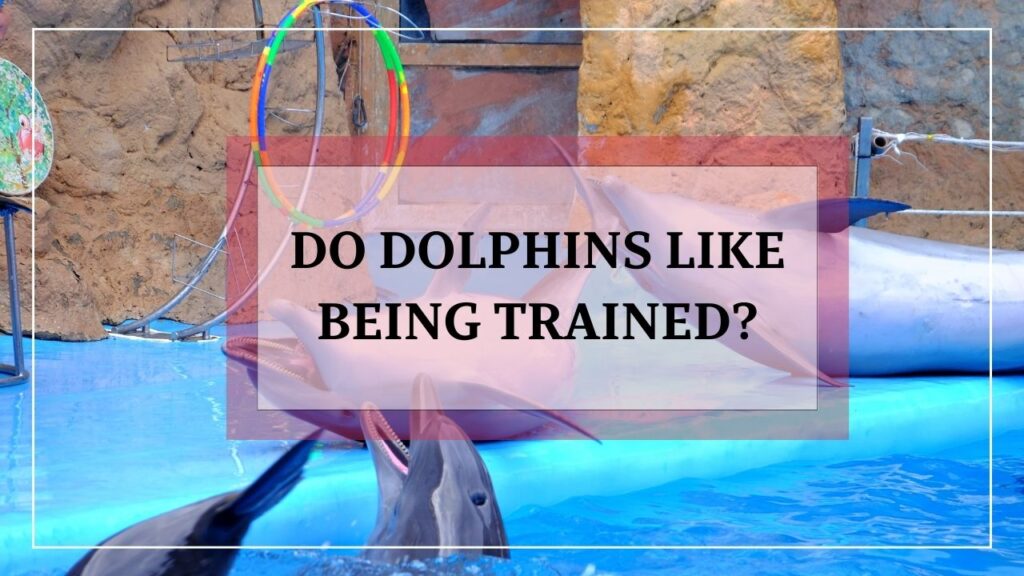These intelligent and social animals have captured the hearts of many people around the world, and it’s not hard to see why. From their playful antics to their seemingly endless curiosity, dolphins have a way of inspiring wonder and amazement in anyone who has the pleasure of encountering them.
In this blog post, I want to delve into one of the most common questions I get asked: do dolphins like being trained?
It’s a question that has been debated among marine mammal trainers and researchers for decades and one that has important implications for the welfare of these magnificent animals.
So, let’s dive in and explore the science behind dolphin training and what it means for these amazing creatures.
Do Dolphins Like Being Trained?

First, let’s get to the heart of the matter: do dolphins actually enjoy being trained? It’s a complex question with no easy answer, but we can examine the concept of “liking” training from a scientific perspective.
First, let’s consider the different types of training methods used for dolphins. In the past, many trainers used negative reinforcement techniques such as punishment or deprivation to force dolphins to perform certain behaviors.
However, in recent years, positive reinforcement training has become the preferred method for most marine mammal trainers.
This involves rewarding dolphins for performing desired behaviors, such as giving them fish or toys, rather than punishing them for not performing them.
So, what does the research say about whether dolphins enjoy positive reinforcement training? There is evidence to suggest that dolphins do, in fact, find it rewarding and enjoyable.
Studies have shown that dolphins are highly motivated by positive reinforcement and that they are more likely to engage in behaviors that lead to rewards.
Additionally, many trainers report that dolphins actively seek out training sessions and show excitement and enthusiasm during them.
However, it’s important to note that there are individual differences in dolphin preferences for training. Just like humans, some dolphins may be more motivated by certain rewards or enjoy certain behaviors more than others.
Trainers must take these differences into account when developing training programs and working with individual dolphins.
Another important consideration is how trainers ensure that dolphins are comfortable during training sessions.
Trainers must be attuned to the dolphins’ body language and behavior, and adjust training sessions accordingly if a dolphin seems stressed or uncomfortable.
Additionally, trainers must provide appropriate enrichment and stimulation to keep the dolphins engaged and mentally stimulated during training sessions.
We can conclude the answer by saying that while the question of whether dolphins “like” being trained is not a simple one, there is evidence to suggest that positive reinforcement training can be enjoyable and rewarding for these intelligent and social animals.
As always, the welfare and well-being of the dolphins must be the top priority for trainers and researchers alike.
The Science of Dolphin Training
When it comes to training dolphins, there are two main methods: positive reinforcement and negative reinforcement. Negative reinforcement involves punishing the dolphin for not performing the desired behavior, such as withholding food or water.
Positive reinforcement, on the other hand, involves rewarding the dolphin for performing the desired behavior, such as giving them a fish or toy.
Benefits Of Positive Reinforcement Training For Dolphins
Positive reinforcement training has several benefits for dolphins. First and foremost, it is a more humane and ethical training method compared to negative reinforcement. It also allows for a more positive and trusting relationship to develop between the trainer and the dolphin.
Additionally, positive reinforcement training can provide mental stimulation and enrichment for the dolphin, as they are constantly learning and engaging in new behaviors.
How Trainers Use Positive Reinforcement To Train Dolphins
Trainers use a variety of positive reinforcement techniques to train dolphins. One common method is called “target training,” where the dolphin is taught to touch a specific target with their body, such as a ball or stick.
Once the dolphin has mastered this behavior, trainers can use the target to guide the dolphin to perform other behaviors, such as jumping or spinning.
Another technique is called “shaping,” where trainers gradually build up behavior by rewarding the dolphin for performing small, incremental steps toward the final behavior.
For example, if the trainer wants the dolphin to jump through a hoop, they may initially reward the dolphin for simply looking at the hoop, then for swimming towards the hoop, and so on, until the dolphin is finally jumping through the hoop.
The Importance Of Trust And Relationship Building Between Trainers And Dolphins
Perhaps the most important aspect of positive reinforcement training is the development of trust and a positive relationship between the trainer and the dolphin.
Trainers must take the time to build trust with their dolphins, through socialization and positive reinforcement.
This allows the dolphins to feel comfortable and safe during training sessions and leads to a stronger and more positive relationship between the trainer and the dolphin.
Do Dolphins Like Captivity?
The answer to whether dolphins like captivity is a complex one. While some dolphins seem to adjust well to life in captivity, the vast majority of scientists and animal welfare experts believe that keeping dolphins in captivity is not in their best interest and can lead to physical and mental health issues.
One issue with captivity is the lack of space and stimulation. In the wild, dolphins have a vast ocean to explore and a complex social structure to navigate.
In captivity, they are confined to a relatively small pool, which can lead to boredom and stress.
Many captive dolphins display stereotypic behaviors, such as swimming in circles or banging their heads against the sides of their tanks, which are indicative of mental distress.
Another issue is the disruption of natural behaviors. In the wild, dolphins hunt for their food and engage in a variety of social and mating behaviors.
In captivity, they are often fed a regimented diet and are not able to engage in these natural behaviors, which can lead to physical and psychological health problems.
But, Why Should We Train Dolphins?
Training is an essential part of the care and well-being of captive dolphins. While training does not fully replicate the complexity and diversity of the wild, it provides mental stimulation and enrichment, as well as improves physical health and well-being.
Mental Stimulation And Enrichment
Training provides dolphins with mental stimulation and enrichment that can help reduce boredom and stereotypic behaviors.
Trainers use positive reinforcement training techniques to teach dolphins a range of behaviors, from basic husbandry tasks such as presenting their flippers for inspection, to complex behaviors like jumping through hoops or performing synchronized swim routines.
Dolphins are intelligent and curious animals, and training provides them with a variety of challenges that can help keep their minds engaged and stimulated.
This mental stimulation can be essential for their overall health and well-being, as it can help reduce stress and prevent the development of stereotypic behaviors.
Improved Physical Health And Well-Being
Training can also improve the physical health and well-being of captive dolphins. Through training, trainers can monitor the dolphins’ health, assess their weight, and check for any signs of injury or illness.
Training can also help dolphins maintain their physical fitness, as it provides opportunities for exercise and allows trainers to develop specialized training programs that can help address specific health issues.
Training can also help dolphins develop positive relationships with their trainers, which can provide them with a sense of security and trust.
This can be especially important for dolphins that have been rescued from the wild or have experienced trauma, as it can help them feel more comfortable in their new environment.
The Role Of Training In Dolphin Conservation Efforts
In addition to its benefits for captive dolphins, training also plays a vital role in dolphin conservation efforts.
Trained dolphins can help researchers study wild dolphin populations, monitor their health and behavior, and assess the impact of human activities on their populations.
Trained dolphins can also assist with rescue and rehabilitation efforts for wild dolphins that have become stranded or injured.
These efforts can be critical for the survival of individual dolphins and the long-term health of wild populations.
FAQs
Do Dolphins Enjoy Doing Tricks?
Yes, they can enjoy doing tricks as long as it is done in a positive reinforcement training environment where they are rewarded for their behaviors.
Will Dolphins Let You Pet Them?
It depends on the dolphin and the situation. In the wild, dolphins are unlikely to approach humans for petting. In captivity, it depends on the individual dolphin’s personality and training.
Do Dolphins Like To Play With Humans?
It depends on the individual dolphin’s personality and their past experiences with humans. Some may enjoy playing with humans, while others may prefer to interact with other dolphins.
How Do You Befriend A Dolphin?
Building a relationship with a dolphin takes time and patience. It is important to approach them with respect, give them space, and offer positive reinforcement through training.
Where Do Dolphins Like To Be Touched?
Dolphins have sensitive skin and enjoy being touched in certain areas such as the back, belly, and flippers.
Do Dolphins Love Their Trainers?
Dolphins can develop strong bonds with their trainers through positive reinforcement training and daily interaction. However, it is important to note that the relationship between a dolphin and its trainer is not the same as a human-to-human relationship.

